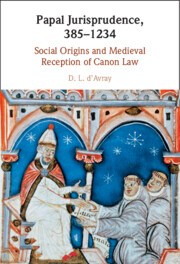Book contents
- Papal Jurisprudence, 385–1234
- Papal Jurisprudence, 385–1234
- Copyright page
- Dedication
- Contents
- Acknowledgements
- Abbreviations
- Sigla
- Introduction
- 1 Transformations and Long-Term Explanations
- 2 The Christian Roman Empire, c. 400
- 3 c. 400: Practical Complexities and Uncertainties
- 4 c. 400: Uncertainty about Grace
- 5 Papal Rulings and Ritual
- 6 Hierarchies
- 7 Clerical Status and Monks
- 8 Returning Heretics
- 9 Pelagianism and the Papacy
- 10 Leo I
- 11 Post-Imperial Syntheses
- 12 Early Papal Laws in the Barbarian West
- 13 Carolingian Culture and Its Legacy
- 14 1050–1150
- 15 Theology and Law
- 16 c. 400 and c. 1200: Complexity, Conversion, and Bigamia
- 17 Clerics in Minor Orders
- 18 Choosing Bishops
- Overall Conclusions
- Book part
- Select Bibliography
- Index
Overall Conclusions
Published online by Cambridge University Press: 10 March 2022
- Papal Jurisprudence, 385–1234
- Papal Jurisprudence, 385–1234
- Copyright page
- Dedication
- Contents
- Acknowledgements
- Abbreviations
- Sigla
- Introduction
- 1 Transformations and Long-Term Explanations
- 2 The Christian Roman Empire, c. 400
- 3 c. 400: Practical Complexities and Uncertainties
- 4 c. 400: Uncertainty about Grace
- 5 Papal Rulings and Ritual
- 6 Hierarchies
- 7 Clerical Status and Monks
- 8 Returning Heretics
- 9 Pelagianism and the Papacy
- 10 Leo I
- 11 Post-Imperial Syntheses
- 12 Early Papal Laws in the Barbarian West
- 13 Carolingian Culture and Its Legacy
- 14 1050–1150
- 15 Theology and Law
- 16 c. 400 and c. 1200: Complexity, Conversion, and Bigamia
- 17 Clerics in Minor Orders
- 18 Choosing Bishops
- Overall Conclusions
- Book part
- Select Bibliography
- Index
Summary
In the late Roman Empire, complexity and uncertainty created demand for responsa from the apostolic see. After the eleventh-century papal turn, new legislation and a different society generated new complexities and uncertainties. Decretals were not the only way to resolve them, but given the prominence of the tradition launched by Siricius and Innocent I, they were an obvious way. An unbroken chain of communication links the first and second decretal ages. Late Antiquity and the central Middle Ages need not be kept in separate compartments.
Keywords
- Type
- Chapter
- Information
- Papal Jurisprudence, 385–1234Social Origins and Medieval Reception of Canon Law, pp. 239 - 241Publisher: Cambridge University PressPrint publication year: 2022

